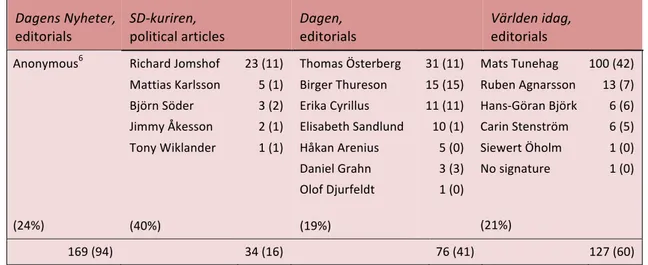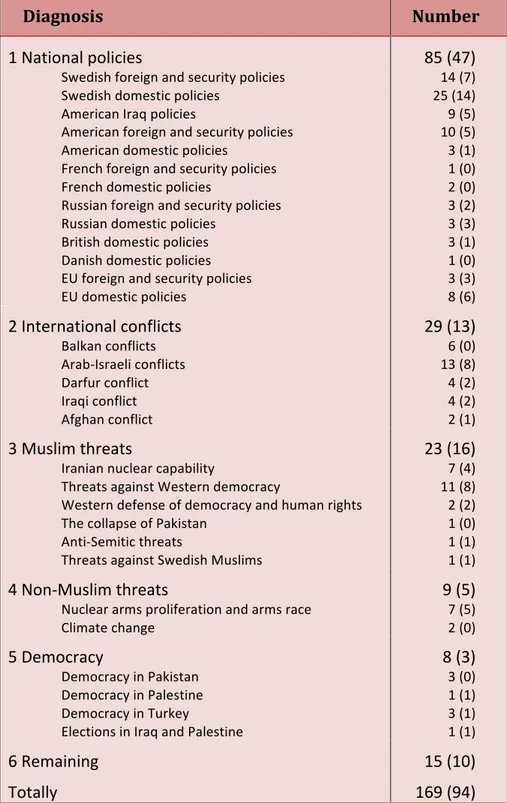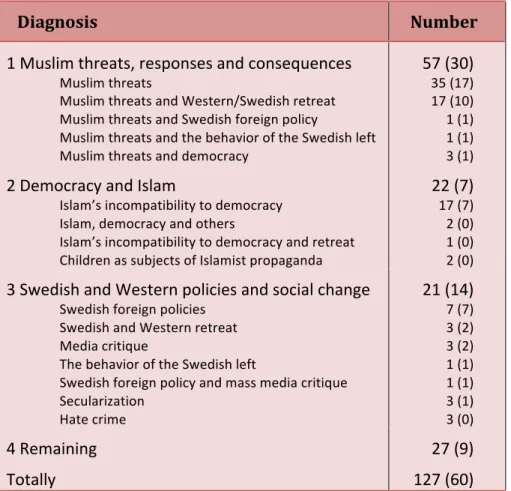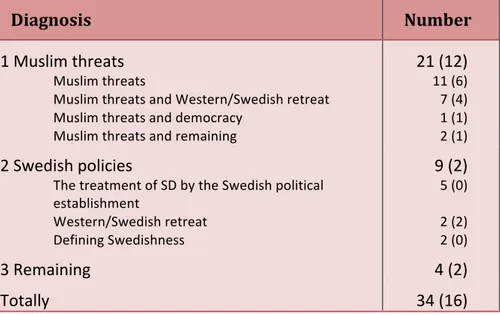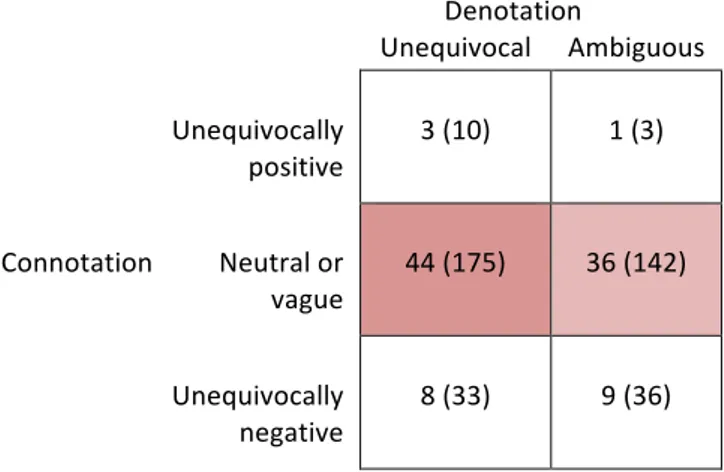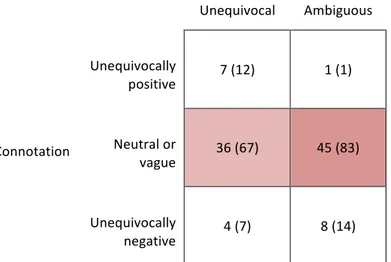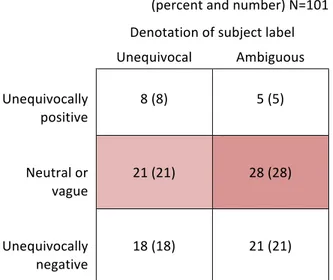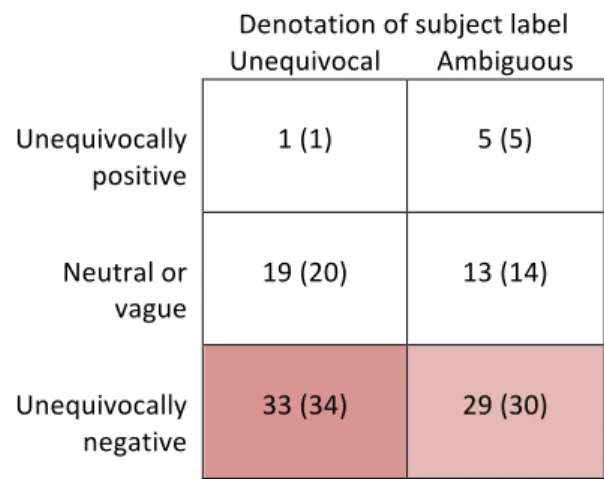Images of Muslims and Islam in Swedish
Christian and Secular News Discourse
Dr. Kristian Steiner
Senior lecturer, Peace and Conflict Studies, Malmö University, Sweden.
Kristian.Steiner@mah.se
Abstract
This is a descriptive comparative quantitative content analysis of the con-‐ struction of Islam and Muslims in 2006-‐2007 in four Swedish publications— the liberal newspaper Dagens Nyheter representing mainstream media, the Evangelical newspaper Dagen, the fundamentalist newspaper Världen idag representing the Christian right, and the journal SD-‐Kuriren, the official organ of the Sweden Democrats, a neo-‐nationalist party. The aim is to see where a chasm between those media which accept the presence of Muslims and Islam in Sweden, and those which do not, occurs. The results put the liberal Dagens
Nyheter and the Evangelical Dagen on one side of the divide and the funda-‐
mentalist Världen idag and the neo-‐nationalist SD-‐Kuriren on the other.
Världen idag and SD-‐Kuriren tend to describe Muslims and Islam as threaten-‐
ing, and ‘our’ elite as retreating. In these two media Muslims are consistently described as aggressive and the cause of social and political problems. Lastly, in both media, Muslims are related to negative behavior; good Muslim behavior is constantly disregarded, while bad behavior is assumed to reflect their true character. Världen idag also claims that Islam is incompatible with democracy. Liberal Dagens Nyheter and Evangelical Dagen avoid describing Muslims and Islam as a threat and more often seek constructive solutions to different problems. Dagens Nyheter moreover describes conflicts between Muslim and Christian actors in political, not religious, terms. Dagen also sees Muslims and Christians alike as victims of the forces of secularization.
1. Introduction
The presence of a Muslim minority in Sweden is recent. Most Swedes have accepted this demographic and societal change, and so have most media and most political parties; the Sweden Democrats being the most important exception. However Sweden is still divided, and there is a chasm between those accepting this change and those who do not.
This is a comparative quantitative content analysis on Swedish media dis-‐ course on Muslims and Islam from 2006-‐2007 in two Christian and two secular publications. The overarching aim is to reveal where an important discursive chasm appears in the Swedish media landscape regarding the perception of Muslims and Islam. Four media have been selected strategically:
Dagens Nyheter,1 the biggest Swedish morning paper, representing a liberal
1 Dagens Nyheter, founded in 1864, is the largest morning newspaper in Sweden with
circulation in weekdays of 285 000 and 330.000 on Sundays. It is regarded as an independent Liberal paper and important leader of public opinion in Sweden since World War II.
and secular Swedish mainstream media. SD-‐Kuriren2 is a much smaller media
product, a journal representing a neo-‐nationalist political party, the Sweden Democrats. Thus, it deviates from Dagens Nyheter in character; in regards to its purpose, size, and independence. Still, since SD-‐Kuriren is the leading neo-‐ nationalist journal or newspaper on the Swedish market it has been selected for analysis.
The two remaining newspapers are conservative Christian and com-‐
paratively small: Dagen3 is conservative, Evangelical, and sometimes called an
ecumenical, paper. Världen idag4 is formally independent, but has close ties to
Livets ord, in Uppsala (Eng. Word of Life), a charismatic fundamentalist church. This is not the first study analyzing Western elite discourse on Muslims and Islam. Such research has been an important academic field ever since Edward Said’s book Orientalism earned repute in the 1980s. According to Said and most scholars within the field, the dominant discourse on Muslims and Islam is negative. Muslims and Arabs have become the predominant ‘other’, and everything that ‘we’ are not (Shaheen 1985: 162). ‘They’ are supposedly irrational (Said 1978: 40, 287, 317), violent and inclined to terror (Beeman 2005: 140-‐8). Since ‘they’ have no proper conscience (Massad 2007: 44) ‘they’ only understand force (Massad 2007: 45) or sometimes shame and humiliation (Said 1978: 4-‐5). Likewise ‘they’ are represented as static, stagnant, misogynic, superstitious (Massad 2007: 13), and despotic (Brasted 1997: 7). Some images change though. Until the end of the nineteenth century, Arabs were described as decadent, in moral decline, degenerate, fallen, and sexually licentious (Massad 2007: 8). Nineteenth-‐century Orientalists had a “fascination with the sexual desires and lives of Arabs” (Massad 2007: 47). Interestingly, today it is in fact the Arabs’ alleged repression of sexual freedoms which the West assaults (Massad 2007: 37). However, over the years ‘they’ remained ‘our’ inferior anti-‐thesis.
According to Said, this discourse became more diffused, and “has seemed more persuasive and influential, in the West than any other ‘coverage’ or interpretation” (Said 1978: 169) since it was reproduced by a variety of discursive elites, such as the academy, the government, poets, novelists, philosophers, political theorists, economists (Said 1978: 2-‐3), and the media (Said 1978: 169). In recent years this discourse has also been reproduced in Eurabia literature, with Gisélle Littman as a frontal figure (Steiner 2010: 58-‐
2 SD-‐Kuriren is a periodical with four annual issues and was founded in 1991 as the official
organ for the Sweden Democrats. It has a circulation of about 28,000. Occasionally it is accessible on Internet.
3 The leader of the Pentecostal movement founded Dagen in 1945. Currently the paper has
18,000 subscribers, Norwegian owners and is regarded as Evangelical or ecumenical.
4 Världen idag was founded in 2001 and has today about 6.600 subscribers. The paper is a part
90) and in Evangelical, foremost Christian Zionist, literature, primarily in the United States, but also in Europe (Steiner 2010: 91-‐135; Steiner 2013).
Studies confirm that media also contributes to Orientalist discourse (Nohrstedt and Camauër 2006: 17; Abrahamian 2003). Arabs and Muslims are represented as violent and threatening (Manning 2006: 131). Muslims also supposedly threaten Western mainstream values and are accused of causing lasting tensions between ethno-‐religious groups in the UK (Poole 2006: 101-‐ 2).
This image is usually not fashioned through explicit statements. More often space is given to negative reports, and little weight is attributed to non-‐ Western sources. Furthermore, the way certain news stories are labelled reveals the interpretative logic governing media. A murder within a Muslim family is by routine labeled as honor killing, thereby giving culture and religion a prominent role (Strand Runsten 2006: 200-‐1, 206). Individual crimes, as with killing, are described as something typical for the group and contribute to stereotypes (Strand Runsten 2006: 209).
Two main circumstances make this research relevant: firstly a possible alliance between neo-‐nationalist movements and conservative Christianity, and secondly presumed consequences of Islamaphobic media discourse.
The last 30 years, a new radical political right has emerged in Europe. The radical right is nationalist and populist, and suspicious towards Islam and Muslims (Mudde 1999:182, 185). The growth of the European radical Right ac-‐ celerated in the 1980s (Mudde, 1999: 182). Several new parties were founded, or created out of splits in established ones. In a few cases, entire established parties turned in a populist, right-‐wing direction (Mudde, 2011: 7). The im-‐ portance of these parties has grown, although their growth has slowed down, and they now have a voting share of around 10% in 12 member states, (Mudde, 2011: 9).
For many years, this new radical right only had minimal success in Sweden. The success of New Democracy in the early 1990s was based on two charismatic leaders. When they stepped down, the party was not re-‐elected to
the parliament (Rydgren, 2005: 8, 75). The Sweden Democrats was founded as
early as in 1988 and was at that time perceived as an almost neo-‐Nazi party with close ties to the movement Maintain Sweden Swedish (Rydgren, 2005: 118). The party was marginalized. About 10 years ago the party was taken over by a set of young leaders who wanted to create a more acceptable right-‐ wing party that could attract ‘welfare nostalgic’ voters in Sweden (Hellström, 2010: 102-‐03). For years this party had little success. In 2010 however, the Sweden Democrats gained seats in the national parliament and its electoral support is supposedly growing.
In Sweden, the growth and success of right-‐wing Christian movements is limited, with one exception; Livets ord in Uppsala. Still, the Christian right has not become a significant political force. Yet, I find it interesting studying an
Islam and Muslim related discourse in these four media, in order to establish to what extent Christian conservative media adheres to a neo-‐nationalist or a liberal discourse. If Dagen, conservative and Evangelical, and Världen idag, fun-‐ damentalist charismatic, demonstrate a discursive consensus with SD-‐Kuriren with neo-‐Nazi roots, this might foreshadow an alliance between right-‐ extremism and neo-‐conservative Christianity, especially since the Swedish Christian Democratic party is losing electoral support. It has been discussed whether the Sweden Democrats would seize the role the Christian Democrats once had. Thus, a discursive consensus regarding Islam and Muslims might indicate that the Sweden Democrats might have an opportunity to gain ground among conservative Christians.
The second reason for conducting this research is consequentialistic. It is well established that the ability to control media language is a power position (van Dijk, 1995: 19), and if such language becomes hostile, it is even conside-‐ red as violence (Galtung, 1990: 291). Lastly, media language has a particular impact in areas where its audience has limited first-‐hand knowledge (Poole and Richardson, 2006: 1), like the readership of Christian papers regarding Is-‐ lam, and if the discourse becomes hegemonic. According to Edward Said, an anti-‐Muslim and anti-‐Arab discourse has not only become mainstream (Said, 1997: xix, 25), it has become “the canonical, orthodox coverage of Islam … and has been more diffused, has seemed more persuasive and influential, in the West than any other ‘coverage’ or interpretation” (Said, 1997: 169). He even claims that what can be said about Muslims cannot be said about any other group; it is the last acceptable form of denigration (Said, 1997: xii, xvi). In any case, since there seem to be some acceptance in the public sphere for anti-‐ Muslim sentiments, Christian media attitudes might be important for its readership.
On a general level, academic literature suggests that violent discourse, such as Islamophobia, has three effects: First of all it affects our ethics, restructures value hierarchies (Kempf, 2010: 13), it “preaches, teaches, admonishes, eggs on, and dulls us into seeing exploitation and/or repression as normal and natural” (Galtung, 1990: 291). It “makes direct and structural violence look, even feel, right—or at least not wrong”, it changes “the moral color of an act”, and it makes oppression legitimate (Galtung, 1990: 291). Truths, ethical considerations and individual rights become subordinate (Kempf, 2010: 13). Injustice, even war becomes necessity and justified (Kempf, 2010: 15). Secondly, a hostile discourse tends to influence (Fairclough, 1993: 138; Winter Jørgensen and Phillips, 1999: 13), and even distort (Wetherell and Potter, 1992: 13) the way we understand and interpret social reality. It makes reality opaque (Galtung 1990: 291), and can blind us to existing oppression (Galtung, 1990: 295).
Interestingly enough, discourse does not only precede or pave the way for violent behavior or oppressing structures. On the contrary, and this is the third
effect, there is a stronger correlation between discrimination and oppressive language than the other way around. Thus, oppressive language has a system justification function; it legitimates existing social arrangements (Jost and Banaji, 1994: 2). This means that “disadvantaged groups are stereotyped in ways that justify their social position” (Jones, 2002: 11), since people cannot endure political systems harming a person who seems like oneself, because it would arouse “feelings of repentance and pain” (Sternberg and Sternberg, 2008: 45).
2. Method
This is a descriptive comparative quantitative content analysis. Using such a method enables the study to see not only differences and similarities between the news products, but also to identify nuances in their respective language (Landmann, 2008: 4-‐5).
The years under scrutiny, 2006 and 2007, were selected since they were years of intense conflict between islamophobic groups in the West and Islamists. Furthermore the political effects of the Danish Mohammed caricatures were evident; resulting in demonstrations and economic boycotts against Denmark. In Sweden, the website of the Sweden Democrats was closed for a short time, since the party published the caricatures. And lastly, parliamentarian elections were held both in Sweden and in the Palestinian territories resulting in a more heated political climate.
Although a wide variety of news materials occur in papers and journals, only the most ideologically distinctive material will be selected, explicitly reflecting the values of the media under scrutiny, i.e. editorials. Of these, those have been selected mentioning Islam and Muslims; Muslim organizations such as Hamas, Muslim terms such as Sharia, and Muslim individuals or ethnic groups with a Muslim majority.
In the case of Dagens Nyheter I have selected only the primary editorials.5
In the period 2006-‐2007, Dagens Nyheter published 710 leaders (356 in 2006), of these 169 concerned Muslims and Islam (94 in 2006).
The previously mentioned selection criteria cannot be fully applied on SD-‐Kuriren. Instead the selection has been expanded, so that not only editorials are included but all articles written by any member of the Sweden Democratic party board. This decision is based on the number of editorials being extreme-‐ ly small in SD-‐Kuriren and could not make a sufficient material for analysis. Furthermore, the selected articles are so politically distinctive that a com-‐ parison with editorials seems relevant. In 2006 and 2007 eight issues of SD-‐ Kuriren were published, and in these issues members of the party board wrote 84 articles. Out of these 84 political articles, 34 were selected, making 40% of all the political articles. Richard Jomshof was the most active writer.
Table 1. Selected editorials and political articles 2006-‐2007 (2006)
Dagens Nyheter,
editorials SD-‐kuriren, political articles Dagen, editorials Världen idag, editorials
Anonymous6 (24%) Richard Jomshof Mattias Karlsson Björn Söder Jimmy Åkesson Tony Wiklander (40%) 23 (11) 5 (1) 3 (2) 2 (1) 1 (1) Thomas Österberg Birger Thureson Erika Cyrillus Elisabeth Sandlund Håkan Arenius Daniel Grahn Olof Djurfeldt (19%) 31 (11) 15 (15) 11 (11) 10 (1) 5 (0) 3 (3) 1 (0) Mats Tunehag Ruben Agnarsson Hans-‐Göran Björk Carin Stenström Siewert Öholm No signature (21%) 100 (42) 13 (7) 6 (6) 6 (5) 1 (0) 1 (0) 169 (94) 34 (16) 76 (41) 127 (60)
Dagen published approximately 200 editorials yearly, one per issue. Out of these 76 editorials (41 in 2006) were selected. Världen idag published approximately 300 editorials yearly, two in each issue. Based on the afore-‐ mentioned criteria, 127 editorials were selected from the 2006-‐07 issues (60 in 2006), which is approximately 21% of all editorials.
Lastly, in this study Robert M. Entman‘s framing analysis functions both as an analytical as well as an organizing tool of the study. According to Entman, framing
is to select some aspects of a perceived reality and make them more salient in a com-‐ municating text, in such a way as to promote a particular problem definition, causal interpretation, moral evaluation and/or treatment recommendation for the item described. Typically frames diagnose, evaluate and prescribe. (Entman, 1993: 52)
Analytically, the study has developed and refined a method based upon Ent-‐ man’s keywords diagnosing, evaluating and prescribing, and is likewise using the same keywords to organize the study into three sections. In some sections, I develop more specific attendant operational questions.
3. The Diagnoses
Editorials and ideological articles are usually spurred by political problems. Success stories are rarely an inspiration. That problems characterize these ar-‐ ticles is not necessarily a consequence of anti-‐Muslim attitudes per se. Never-‐ theless, a problem arises when European Muslims do not possess tools to ar-‐ ticulate alternative public images. Statements might go unchallenged and con-‐ tribute to an anti-‐Muslim discourse.
6 Traditionally, editorials are anonymous and merely the voice of the newspaper, like in the
It is difficult to categorize editorials according to their diagnoses, some-‐ times there is more than one, and sometimes they are unclear. Still, the editorials are classified inductively, identifying the most pertinent diagnoses without predefined categories, the reason being that this makes the articles at this early stage appear open-‐ended and in their own right.
Table 2a. Diagnosis, the motive for editorials with a Muslim presence in Dagens Nyheter 2006-‐2007 (2006)
Diagnosis Number
1 National policies
Swedish foreign and security policies Swedish domestic policies
American Iraq policies
American foreign and security policies American domestic policies
French foreign and security policies French domestic policies
Russian foreign and security policies Russian domestic policies
British domestic policies Danish domestic policies EU foreign and security policies EU domestic policies
85 (47) 14 (7) 25 (14) 9 (5) 10 (5) 3 (1) 1 (0) 2 (0) 3 (2) 3 (3) 3 (1) 1 (0) 3 (3) 8 (6) 2 International conflicts Balkan conflicts Arab-‐Israeli conflicts Darfur conflict Iraqi conflict Afghan conflict 29 (13) 6 (0) 13 (8) 4 (2) 4 (2) 2 (1) 3 Muslim threats
Iranian nuclear capability
Threats against Western democracy
Western defense of democracy and human rights The collapse of Pakistan
Anti-‐Semitic threats
Threats against Swedish Muslims
23 (16) 7 (4) 11 (8) 2 (2) 1 (0) 1 (1) 1 (1) 4 Non-‐Muslim threats
Nuclear arms proliferation and arms race Climate change
9 (5)
7 (5) 2 (0)
5 Democracy
Democracy in Pakistan Democracy in Palestine Democracy in Turkey
Elections in Iraq and Palestine
8 (3) 3 (0) 1 (1) 3 (1) 1 (1) 6 Remaining 15 (10) Totally 169 (94)
In the case of Dagens Nyheter (table 2a), its most common diagnosis concerns national policies, domestic or foreign, of different states. Furthermore, Dagens Nyheter is mainly using a non-‐religious discourse. Religion is rarely described as the motivation for political actors. The same can be said about the other categories; whenever international conflicts, threats, and democracy are dis-‐ cussed the role of religion is downplayed. Likewise, violence and political pro-‐ blems are dressed in a political language, not a religious one. Muslim actors are portrayed as politicians with a political, not a religious, agenda. This also holds true in the case of future Iranian nuclear capability (Dagens Nyheter, 16 January, 2006).
In Dagen (table 2b), the dominant category concerns secularization of the Swedish society, particularly Swedish schools. In these cases Muslims and Christians sometimes share the same challenge (Österberg, 30 November 2006), occasionally Muslims are used by anti-‐Christian actors with the pursuit of secularizing schools (Österberg, 13 June 2006; Cyrillus Olsson, 22 August 2006). But Muslim actors are never described as the central actor causing secularization.
Table 2b. Diagnosis, the motive for editorials with a
Muslim presence in Dagen 2006-‐2007 (2006)
Diagnosis Number
1 Swedish policies
Secularization in Sweden
Attitudes towards Muslims in Sweden Swedish immigration policies
Swedish defense policies
27 (18)
18 (14) 4 (2) 3 (1) 2 (1)
2 International conflicts and conditions
The relationship between Muslims and Christians or the western world
The Israeli-‐Palestinian conflict The Iraq conflict
Poverty and conflicts in the third world
30 (15) 11 (6) 10 (6) 5 (2) 4 (1) 3 Democracy
Threats against freedom of expression Islam and democracy
7 (3)
5 (2) 2 (1)
4 Human rights
Possession and proliferation of nuclear arms Death penalty 4 (3) 2 (2) 2 (1) 5 Remaining 8 (2) Totally 76 (41)
Another major category concerns the relationship between Muslims and Chris-‐
tians or the western world. In this category7 threats are present. However Is-‐
lamism, not Islam, is defined as an inspiration for terrorism in Sweden (Thure-‐ son, 5 May 2006), and is said to be “advancing” (Thureson, 8 June 2006) or responsible for terrorism in Great Britain (Österberg, 11 August 2006; Sand-‐ lund, 5 July 2007).
A third theme concerns the Israeli-‐Palestinian conflict. In this period the war between Hezbollah and Israel in the summer 2006 was a central theme as well as the fact that Hamas won the Palestinian elections and the illness of Ariel Sharon. Problematic Arab actors are described as individuals, not as representatives of Arabs or Muslims in general. Still, Palestinian leaders are repeatedly described as causing the conflict; they fight each other (Cyrillus, 14 June 2006), Hamas refuse to recognize Israel (Österberg, 4 April 2007; Thureson 1 August 2006), with the pursuit of eradicating Israel (Thureson, 11 May 2006). On the other hand, the Palestinian population is described as long-‐ ing for peace (Thureson, 11 May 2006).
In Världen idag (table 2c) by far the most reoccurring diagnose concerns different Muslim threats, one kind being physical threats posed against the West. Islam allegedly threatened Denmark during the hot-‐headed demonstra-‐ tions against Jyllands-‐Posten, the Danish paper that published the Mohammed caricatures (Tunehag, 2 January 2006). Furthermore, the life of a reporter at the Norwegian Christian paper, Magazinet, was threatened, and Hans-‐Göran Björk speculates whether this reveals the true face of Islam (Björk, 13 January 2006). The fact that the Danish embassy in Damascus was set on fire (Sten-‐ ström, 6 February 2006) and that the leaders in Iran launched a nuclear pro-‐ gram (Tunehag, 10 March 2006) are seen as additional physical threats against the West.
Likewise, Muslims allegedly threaten Western immaterial core values, such as religious freedom, democracy, and freedom of speech and expression. The existence of radical Muslims in Europe is one such threat (Tunehag, 31 January 2007). In one editorial, The Islamic Republic of Sweden?, it is implied that British Muslims threaten democracy and support Sharia (Tunehag, 8 March 2006), and in another one, that ‘we’ all might be forced to follow Islam (Tunehag, 13 February 2006).
A second theme appearing in some editorials is the retreat of various Western elites from important Christian or democratic values, particularly when facing a Muslim threat. This retreat is described in a typically populist vein. It is supposedly caused by Muslim immigration and ignorant and naïve Western elites fearing Muslim immigrants. A clear case is the excuse Den-‐ mark’s Prime Minister and the chief editor of Jyllands-‐Posten gave the Muslim
7 Threat is also present in articles concerning the Israeli-‐Palestinian conflict and in the ones
world after publishing the Mohammed drawings. Allegedly, ‘they’ are now let-‐ ting Islam rule a Scandinavian democracy (Björk, 3 February 2006). Not only is the political elite sounding the retreat, so also are “ignorant secularists” and “media” as well (Tunehag, 7 June 2006). ‘They’ allow a self-‐censorship to wild-‐ fire, limiting the freedom of speech and expression, especially in issues related
to Islam and homosexuality (Tunehag, 8 November 2006).
Table 2c. Diagnosis, the motive for editorials with a
Muslim presence in Världen idag 2006-‐2007 (2006)
Diagnosis Number
1 Muslim threats, responses and consequences
Muslim threats
Muslim threats and Western/Swedish retreat Muslim threats and Swedish foreign policy
Muslim threats and the behavior of the Swedish left Muslim threats and democracy
57 (30) 35 (17) 17 (10) 1 (1) 1 (1) 3 (1)
2 Democracy and Islam
Islam’s incompatibility to democracy Islam, democracy and others
Islam’s incompatibility to democracy and retreat Children as subjects of Islamist propaganda
22 (7)
17 (7) 2 (0) 1 (0) 2 (0)
3 Swedish and Western policies and social change
Swedish foreign policies Swedish and Western retreat Media critique
The behavior of the Swedish left
Swedish foreign policy and mass media critique Secularization Hate crime 21 (14) 7 (7) 3 (2) 3 (2) 1 (1) 1 (1) 3 (1) 3 (0) 4 Remaining 27 (9) Totally 127 (60)
A third diagnosis concerns the perceived incompatibility between Islam and democracy. Islam is described as genuinely undemocratic. Muslim societies are supposedly unable to adopt democratic values (Tunehag, 27 February 2006). Tunehag calls democratic Islam a “square circle”: a contradiction in terms (Tunehag, 30 January 2006).
The analysis of SD-‐Kuriren (table 2d) establishes major rhetorical simi-‐ larities with Världen idag, but also some differences. A shared feature is the alleged Muslim threat as a reoccurring theme. Threat is the dominating or one of two dominating problems in more than 60% of the selected political articles. This is a larger proportion than in Världen idag.
Unlike Världen idag, SD-‐Kuriren never claims that Islam as such is incom-‐ patible to democracy. However, just like Världen idag, SD-‐Kuriren dwells on the idea that Muslims in Europe constitute a threat to democracy. In 2006, Richard
Jomshof describes the reactions against the publications of the Mohammed images as a threat and an assault on the free and democratic Denmark, enabled by Danish Muslims, labeled “fifth columnists” (Jomshof, 67b, 2006). This expression reoccurs in an article by Björn Söder, who claims that Muslims conduct “fifth column activities” (Söder, 67, 2006). Söder also refers to Pia Kjærsgaard, claiming that ”there are strong Muslim forces that wish to curtail our democratic rights” (Söder, 69, 2006).
Furthermore, the writers return to the idea that the Muslim threat is per-‐ manent and growing since ‘they’ are here, their number is growing and since ‘they’ assumedly are getting more radical. The Muslim group assumedly “grow increasingly fast” through “mass immigration and high nativity” (Jomshof, 69a, 2006), and “will cause very big problems in the future” (Jomshof, 69a, 2006) as they will demand “antidemocratic Sharia laws”, Muslim autonomy and seg-‐ regation (Jomshof, 69d, 2006).
Table 2d. Diagnosis, the motive for editorials with a
Muslim presence in SD-‐kuriren 2006-‐2007 (2006)
Diagnosis Number
1 Muslim threats
Muslim threats
Muslim threats and Western/Swedish retreat Muslim threats and democracy
Muslim threats and remaining
21 (12) 11 (6) 7 (4) 1 (1) 2 (1) 2 Swedish policies
The treatment of SD by the Swedish political establishment Western/Swedish retreat Defining Swedishness 9 (2) 5 (0) 2 (2) 2 (0) 3 Remaining 4 (2) Totally 34 (16)
These problems are understood as permanent since cultures, in Richard Jomshof’s mindset, do not converge. The system with independent schools, furthermore, will contribute to the permanency of the problem giving Muslims the opportunity to reproduce its culture and religion independently (Jomshof, 74b, 2007). Being an ardent supporter of Christian independent schools, Världen idag refrain from this critique.
Just as in Världen idag, also in SD-‐Kuriren Muslims are portrayed as violent and irrational. The threat they constitute is not merely a threat to democratic ideas, but they also supposedly constitute a real physical threat and a threat to law and order. In 2005 violent riots took place in some of the suburbs of Paris and in 2007 SD-‐Kuriren reported on riots in Netherlands (Jomshof, 72b, 2007). Jomshof and Söder depict how Muslim youth in France make up the basis of the problem and cause a situation described as the “brink
of civil war” (Jomshof and Söder, 67, 2006). In the same article it is also said that an “Arab mob”, without any rational reasons, assaulted passengers on a train in Nice. The authors also emphasize that this is not an isolated French threat, but also a Swedish and European one.
SD-‐Kuriren stresses that crime and sexual violence is yet another kind of Muslim threat and an outcome of Islam. In the mindset of SD-‐Kuriren, crime is not merely a social or legal issue, if the perpetrator is Muslim. Crime is understood as a part of a global war between the Muslim world and the West (Karlsson, 74, 2007; Karlsson, 68, 2006) and is seen as an outcome of Islamic attitudes, since ”Muslim violence against infidels to a large extent is based upon attitudes towards women, men, sex, and violence thriving in Muslim societies” (Jomshof, 74a, 2007).
Another reoccurring theme in SD-‐Kuriren is the retreat of Western elites. Herein lies SD-‐Kuriren’s populist dimension, shared by Världen idag; voicing a mistrust of national elites and depicting them as ignorant and blind to massive threats posed by Islamic presence in the West. Moreover, a wide group of elites is criticized. One is artists. SD-‐Kuriren claims that the refusal of children’s book illustrators’ to make drawings of Mohammed was a retreat and the origin of the crisis (Jomshof, 67b, 2006). This was understood by SD-‐Kuriren as a symptom of that Denmark voluntarily “subject” itself to “Islamic censorship”. Likewise, Jomshof regards the refusal to accept Lars Vilks’ participation in an exhibition in Karlstad in the summer 2007 (Jomshof, 73, 2007) as well as the closure of SD-‐Kuriren’s website in 2006, probably under pressure from the
foreign minister (Jomshof, 67a, 2006; Jomshof, 69b, 2006; Jomshof, 74c, 2007)
as yet other symptoms of retreat.
Just as Världen idag, SD-‐Kuriren sometimes uses historical analogies, comparing contemporary actors to the ones in the 1930s and -‐40s. Scandinavi-‐ an media is described as appeasers (Wiklander, 67, 2006), and similarly, Dutch media allegedly “suppress and belittle” the riots outside Utrecht (Jomshof, 72b, 2007). Furthermore, Swedish and British politicians are described as “appe-‐ asers” against those Muslims who want to impose Sharia (Jomshof, 68, 2006).
4. Evaluation of Muslims’ Moral Character
The second phase in Entman’s framing method concerns the moral evaluation of actors in a discourse. This extensive section is divided into subsections based on more specific attendant operational themes. The first section is ana-‐ lyzing explicit claims regarding Muslims’ moral character, and the second im-‐ plicit ones.
4.1. Explicit Descriptions of Muslims
In this analysis regarding explicit claims about Muslims and Islam, the roles Muslims are given in the articles will be analyzed; thereafter attention will be
given to the usage of labels and complements. Exploring the role Muslims play in relation to diagnoses in editorials, the extent Muslims are regarded as problem-‐makers, as possessing a passive, neutral, unclear role or described as problem-‐solvers, will be studied.
News media differ greatly with respect to assignment of responsibilities. As table 3 indicates, the four media can be divided into those where Muslim actors in general have a neutral, passive or unclear role, and those where Mus-‐ lim actors in general have the role as rejected problem-‐makers. The reason for this difference is, in addition to ideological differences, the fact that Muslims are not in main focus in many of the editorials in Dagen, such as in articles on secularization. In the case of Dagens Nyheter, several articles focus on political structures and contexts, explaining a political problem, and tend to downplay the role of actors, including Muslim ones.
Table 3. The roles of the Muslim actors in relation to
the problems and diagnoses of the editorials (percent and number)
Muslim actor in
Dagens Nyheter
2006-‐07 N=167
Muslim actor in
Dagen
2006-‐07 N=76
Muslim actor in
Världen idag
2006-‐07 N=127
Muslim actor in
SD-‐Kuriren 2006-‐07 N=34 Rejected problem-‐maker 40 (67) 36 (27) 81 (103) 77 (30) Passive, neutral
or unclear role 77 (128) 70 (53) 38 (48) 15 (6) Accepted
problem-‐solver
7 (11) 14 (11) 9 (11) 8 (3)
In Världen idag, as well as in SD-‐Kuriren, Muslims are repeatedly described as problem-‐makers. However, there is one difference; in the case of Världen idag Muslims relatively often also have a passive, neutral, or unclear role. The rea-‐ son is that several articles in Världen idag, unlike SD-‐Kuriren, depict different Muslim actors in different roles, i.e. more than one kind of Muslim actor is present.
The analysis of the usage regarding labels denoting Muslims, deals with the denotative precision and connotative value of labels (Ottosen, 1995:100). Combining negative connotations with vague denotations is an effective strate-‐ gy to incite prejudice. 8
8 The concept of connotation is complicated. There is no impartial wordlist naming all
dysphemisms and euphemisms. What is a disparaging label depends on the context (Ejvegård 2005: 16). If there is reason to believe that a writer has the intention to speak in a derogatory manner, to vulgarize, or to describe someone as offensive, then the term is disparaging, particularly if we believe that the audience understands the terms in question in the same way.
In this case no major differences between the four media appear. All of them seem to consciously avoid dysphemisms, and other labels with negative connotation (table 4a-‐d). However, that does not mean that the usage of labels is identical, as a few qualitative examples might illustrate.
As in the other media, neutral or vague labels dominate in Dagens Nyheter. And furthermore, 46% of the labels denote ambiguously. Further-‐ more, the fact that the editorials have a secular language, also have an im plication on the usage of labels depicting Muslims; they are usually secular. Also in the ones with negative connotation, about 17%, Dagens Nyheter regularly avoids emphasizing their Muslim character. Regimes, governments, terrorists, presidents are rarely referred to as ‘Muslim’ regimes or a ‘Muslim’ government and so on. Also when “fanatics” are being discussed, they are not referred to as ‘Muslim’, and “extremists” furthermore, are referred to as “extremists of both sides” (Dagens Nyheter, 7 February 2006).
Table 4a. Labels denoting Muslim actors in Dagens Nyheter 2006-‐2007 (percent and number) N=399
Denotation Unequivocal Ambiguous Unequivocally positive 3 (10) 1 (3) Connotation Neutral or vague 44 (175) 36 (142) Unequivocally negative 8 (33) 9 (36)
The usage of labels in Dagen resembles to a large extent the one in Dagens Nyheter, particularly regarding the distribution of the labels in the different categories. But since Dagen is Evangelical, it has a tendency to have a more religious language, to Islamize labels designating Muslim actors, turning mili-‐ tant actors into “militant Muslims” (Thureson 1 February 2006) and regimes into “theocratic Arab countries” (Cyrillus 15 November 2006). This might be a bit surprising since Dagen tends to have a more benign outlook on Islam and Muslims in other respects.
Table 4b. Labels denoting Muslim actors in Dagen 2006-‐2007 (percent and number) N=222
Denotation Unequivocal Ambiguous Unequivocally positive 1 (3) 4 (9) Connotation Neutral or vague 35 (77) 47 (104) Unequivocally negative 5 (12) 8 (17)
Världen idag’s 127 editorials have 608 labels of Muslims, significantly more than Dagens Nyheter publishing significantly more editorials. Of these labels, 13% fall into the category of labels with an unequivocally negative con-‐ notation (table 4c), the same proportion as Dagen. And labels with vague or neutral connotation dominate, as in other media. Labels with a positive connotation are exceptionally rare.
Of the labels denoting Muslims, 54% denote ambiguously, 46% include terms combining an ambiguous denotation and a neutral or vague connotation such as “Muslims”, “Islam”, “Muslims in our countries” or “Muslim groups”.
Table 4c. Labels denoting Muslim actors in Världen idag 2006-‐2007 (percent and number) N=608
Denotation Unequivocal Ambiguous Unequivocally positive 0.5 (3) 0.5 (3) Connotation Neutral or vague 39 (239) 46 (281) Unequivocally negative 5 (33) 8 (49)
Of course, the most problematic category is the one combining derogatory connotation with unspecific denotations, and here we find “Islamic extremists” (Björk, 13 January 2006), “this religion of violence” (Stenström, 6 February 2006), “dangerous religion”, (Stenström, 6 February 2006), “the wolfs” (Björk, 8 May 2006), “the terrorists” (Tunehag, September 6 2006), and “these bawlers” (Tunehag, 18 September 2006).
SD-‐Kuriren’s usage of labels is consistent with the other media (table 4d). In 34 articles, 184 labels denoting Muslim actors have been found, 12% are classified as negative. This means that just as other media, SD-‐Kuriren does not allow labels with negative connotation to dominate. Likewise, vague or neutral labels dominate the editorials in SD-‐Kuriren.
In all of the publications, except Dagens Nyheter, there is a tendency to ambiguity. In SD-‐Kuriren 54% of the labels denoting Muslims are ambiguous, possibly indicating that the writers generalize to same extent, but avoid using negatively charged labels. The dominant category is labels combining an ambiguous denotation with a neutral or vague connotation, such as ”Muslims” (Jomshof, 67a, 2006; Jomshof, 72b, 2007; Jomshof, 74b, 2007), ”increasingly more Muslims” (Jomshof, 67a, 2006; Jomshof, 69a), “strong Muslim forces” (Söder, 67, 2006), and “Islam” (Söder, 67, 2006; Söder, 69, 2006; Jomshof, 72a, 2007).
The most ethically problematic labels, those combining a denotative ambiguity with negative connotation, represents 8% of the total. In the case of Världen idag many of these labels were clear dysphemisms. In SD-‐Kuriren all the dysphemisms are borderline cases, less malicious forms of dysphemisms,
Table 4d. Labels denoting Muslim actors in SD-‐kuriren 2006-‐2007 (percent and number) N=184
Denotation Unequivocal Ambiguous Unequivocally positive 7 (12) 1 (1) Connotation Neutral or vague 36 (67) 45 (83) Unequivocally negative 4 (7) 8 (14)
such as “a too big Muslim population in Sweden” (Jomshof, 69a, 2006; Jomshof, 74b, 2007), “Muslim fundamentalists” (Jomshof, 74b, 2007) and the “alleged moderate Muslims” (Karlsson, 72b, 2007).
All in all, this implies that the four media in many ways coincide in the usage of labels as an instrument to describe Muslims although ambiguous are considerably more vulgar in the case of Världen idag.
In the scrutiny of explicit descriptions of Muslims, we have now come to complements, i.e. the clause element describing what Muslims are, what they are not and so on. Such statements are divided into six categories, into those
making clear positive statements, neutral or vague statements, and complements making unequivocally negative statements. Moreover, the statements are divided along another dimension concerning the denotative clarity of the subjects in the clauses. Of course, the most malicious clause combines an ambiguous actor with a negative complement.
In this case, the four media falls into two categories; those where neutral or vague complements dominate (Dagens Nyheter and Dagen) and those where negative ones dominate (Världen idag and SD-‐Kuriren). Furthermore, Dagens Nyheter’s complements express secular, and political conditions, also when terrorism is described. For instance “the terrorist is a dangerous and unpredictable enemy” (Dagens Nyheter, 11 August 2006). Furthermore, as an effect of the secular discourse in this newspaper, the subjects in the sentences, although defined as Muslim, are of a secular and very neutral character, like countries, politicians and organizations, and so on.
Table 5a. The Use of Complements describing
Muslims in Dagens Nyheter 2006-‐07
(percent and number) N=101
Denotation of subject label
Unequivocal Ambiguous Unequivocally positive 8 (8) 5 (5) Complements Neutral or vague 21 (21) 28 (28) Unequivocally negative 18 (18) 21 (21)
Dagen resembles Dagens Nyheter in its usage of Muslims complements; neutral and vague ones dominate. And furthermore, although Dagen has more of a religious language, it does not affect its usage of complements. Both its sub-‐ jects and the complements are dominated by secular terms. The religious subjects that do exist are predominantly positive or in some cases neutral, like “moderate Muslims are an overwhelming majority in our country” (Thureson, 17 May 2006). And lastly, sentences with negative complements are usually describing corrupt politicians and organizations.
